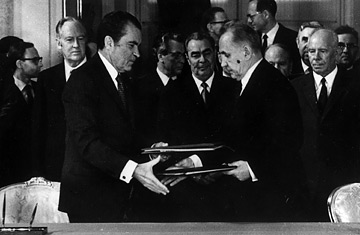
President Nixon exchanges cosmic-space-cooperation documents
Jan. 5, 1972 — Partisans and space purists never quite got over the fact that when the U.S. finally reached its goal of landing on the moon, it was Richard Nixon — whose presidency was just six months old to the day — who got to do the end-zone dance. Eisenhower had started the space ball rolling, Kennedy had pushed it forward and Johnson had sustained it, and now it was Nixon who would talk to the Apollo 11 crew on the surface of the moon, in an intrusive split screen, then greet all three men aboard the aircraft carrier after splashdown. Worse, Nixon was never a champion of the moon program to begin with. NASA had planned on 10 landings — running from Apollos 11 through 20. Apollo 13 exploded, and budget cuts forced the cancellation of Apollos 18, 19 and 20. Before Apollos 16 and 17 even flew, Nixon announced that those would be the last moon landings and that the nation would instead turn its attention to building an affordable, reusable, reliable space shuttle that would make traveling in orbit as easy and safe as a flight from Washington to Boston. Things didn't quite work out that way.